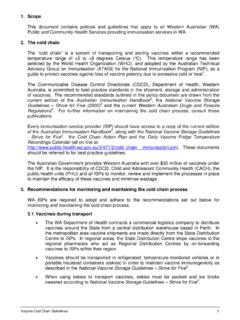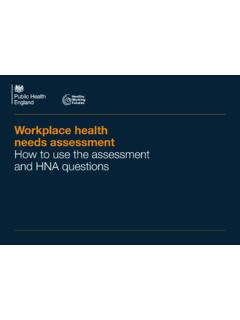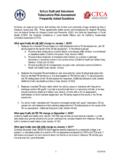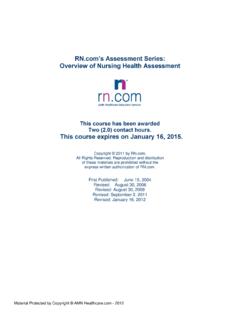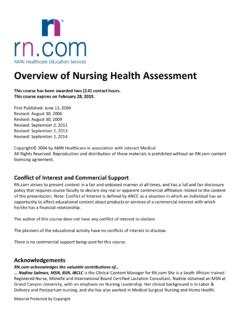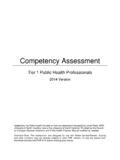Transcription of Clinical risk assessment and management (Cram) in western ...
1 Clinical risk assessment and management (CRAM). in western australian Mental health services Policy and Standards HP10607 APRIL'08 22909. Department of health , 2008. Produced by the Mental health Division Department of health , State of western Australia (2008). Copyright to this material produced by the western Australian (WA) Department of health belongs to the State of western Australia, under the provision of the Copyright Act 1968 (Commonwealth of Australia). Apart from any fair dealings for personal, academic, research or non-commercial use, no part may be reproduced without written permission of the Mental health Division, WA Department of health .
2 The WA Department of health is under no obligation to grant this permission. Please acknowledge the WA Department of health when reproducing or quoting material from this source. Disclaimer All advice and information in this document is given in good faith and is based on sources believed to be reliable and accurate at the time of release. The State of western Australia, the WA Department of health and their respective officers, employees and agents do not accept legal liability or responsibility for the content of this advice or information or any consequences arising from its use.
3 Suggested reference: Mental health Division, WA Department of health (2008). Clinical Risk assessment and management (CRAM) in western Australian Mental health Services: Policy and Standards. Perth, western Australia: Department of health . Po l ic y a nd st a n d ar d s Executive director's foreword The Clinical Risk assessment and management Project was implemented under Key Initiative 5 (Workforce and Safety Initiatives) of the Mental health Strategy 2004-2007 from a long-standing need to develop a consistent approach to Clinical risks in mental health settings.
4 A Project Reference Group of consumer and carer representatives, clinicians and service managers was formed to provide specialist input into the project. The Project Reference Group spent many hours considering the current literature and evidence base, including guidelines and frameworks from other services, internationally, from other states, and from our own services. It also spent many hours deliberating about what happens in the real world' of mental health practice and what could be realistically done to manage Clinical risks . From the outset, the Project Reference Group acknowledged that mental health services in western Australia are committed to the best outcomes for consumers, carers and staff .
5 It became clear though that services had different procedures for assessing risk and that they offered different types of training related to Clinical risk management , for example aggression management courses. One of the original aims of the project was to develop a Clinical framework for risk assessment and management and to develop a training package. Whilst undoubtedly important, it became apparent that a Clinical framework or risk assessment tool is not enough to ensure consistent evidence-based risk management practice across the state. The Project Reference Group defined a standardised approach for services to assess and manage Clinical risks that could then be tailored to the specific service requirements of each service.
6 The result is a policy that details five steps to identify, assess and manage Clinical risks in mental health settings. The policy outlines a standardised approach to Clinical risk assessment and management throughout the western Australian public mental health service. The aim is that through Clinical governance processes, services can use the policy to develop new, or audit existing, procedures. Finally, I would like to thank the Project Reference Group for their hard work and commitment in producing the policy and standards. Dr Steve Patchett Executive Director, Mental health i Clinical risk assessment and management in western australian Mental health services ii Po l ic y a nd st a n d ar d s Table of Contents Executive Director's Foreword i 1.
7 POLICY 1. Policy Statement 1. Scope 1. Objectives 1. Relevant Documents 2. Legislation and Codes 2. Standards 2. Policy and Guidelines 2. Operational Circulars 2. Source Documents 3. Policy Background 5. The Clinical Risk assessment and management Project 5. Remit of the Reference Group 5. Policy Development 5. 2. STANDARDS FOR Clinical RISK assessment AND management 8. risks : An outline 8. The Clinical Risk management Process 9. Standards 11. 3. IMPLEMENTATION 31. Staged Implementation 31. Auditing 31. Training and Development 31. Policy Review 32. 4. ACKNOWLEDGEMENTS 33.
8 5. GLOSSARY 35. 6. REFERENCES 38. iii Clinical risk assessment and management in western australian Mental health services iv Po l ic y a nd st a n d ar d s 1. Policy Policy Statement One of the outcomes of the National Mental health Plan 2003-2008 has been the increased safety of consumers, carers and families, staff and the community. western Australian mental health services are committed to the safety and well-being of consumers, carers and staff and will work to minimise the likelihood and impact of adverse Clinical risks . Mental health staff have the right to work in a safe environment, and consumers and their carers have a right to receive mental health care in an environment that actively works to protect their safety.
9 However, mental health services are never risk-free and Clinical risks like suicide and violence cannot be predicted with 100% accuracy. Instead, good Clinical risk management is based on effective treatment that is focused on an individual's history and current circumstances. In order to minimise the possibility of harm to consumers, their carers and staff , services require: A common, evidence-based understanding of the principles of Clinical risk assessment and management to support a consistent approach and process. The capacity to manage Clinical risks that includes the appropriate allocation of staffing, access to training and the ability to manage and rectify the physical work environment.
10 This policy outlines the minimum requirements for safe practice in this area. At the outset, it should be acknowledged that services and staff often already demonstrate evidence-based, safe practice in this area. This policy therefore aims to highlight and support existing safe practice and provide a structure for accountability. Scope This policy applies to all clinicians and managers in the western Australian public mental health services. It is a system-wide policy that supersedes all policies and guidelines related to Clinical risk assessment and management previously produced by the Mental health Division.




